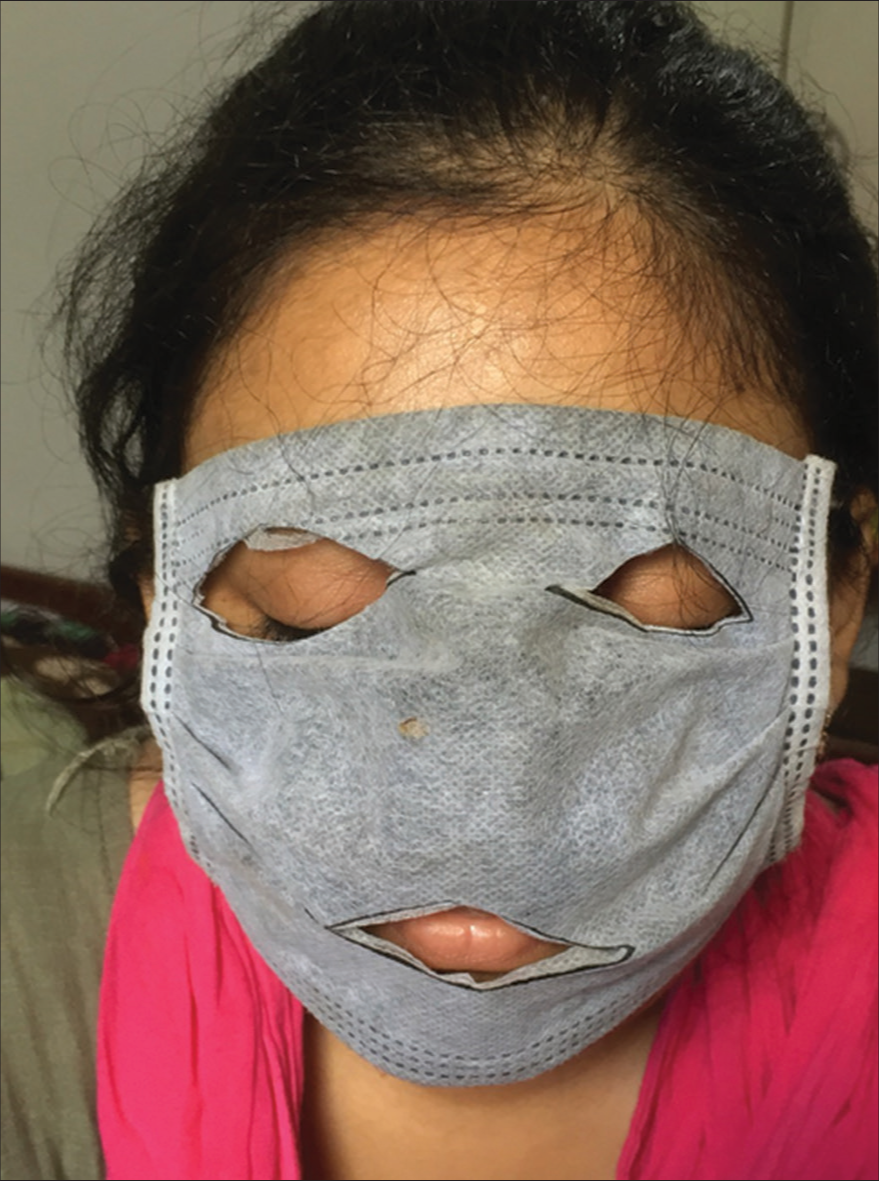Translate this page into:
A unique use of a face mask for photoprotection during Psoralen-UVASol for eyelid and lip vitiligo
*Corresponding author: Muhammed Mukhtar, Department of Dermatology, Mukhtar Skin Centre, Katihar Medical College Road, Katihar, Bihar, India. drmmukhtar20@gmail.com
-
Received: ,
Accepted: ,
How to cite this article: Mukhtar M. A unique use of a face mask for photoprotection during Psoralen-UVASol for eyelid and lip vitiligo. J Cutan Aesthet Surg. 2024;17:254-5. doi: 10.4103/JCAS.JCAS_147_22
Dear Editor,
Long-term photoprotection of the eyes, lips, and face is required for Psoralen-UVASol or PsoralenUVA therapy, particularly for vitiligo lesions on the face, eyelid, and lip.1 Several photoprotection techniques are suggested.2 Although they are quite successful, they are not generally available to patients. Patients were unable to use and protect their eyes, lips, and faces from phototoxic damage despite the recommendations. The face mask is a good option for photoprotection, which is determined by the colors, layers, material kinds, fabric types, and their properties of the clothes.
Black or dark-colored, multilayered face masks (surgical, homemade) composed of densely woven cotton or its mixture with silk or polyester provide excellent photoprotection along with protection from virus.3,4 We recommend to use the mask for Psoralen-UVASol therapy to protect the face.
For the patient, we selected an optimal-sized, dark-colored, three-layered face mask. In the clinic, the mask is cut to fit the size of the eyelids and lips (1 × 2 in for the eyelids and 1/2 × 2 in for the lips). Then, the mask is supplied to the patients to wear during Psoralen-UVASol or sunlight exposure over the vitiligo lesions [Figure 1]. Thus, sun exposure is limited to the spot, and the face is protected from phototoxicity. A black multilayered face mask is effective to absorb approximately 100% of ultraviolet, visible, and infrared radiation. These masks are washable and durable, and they may be used multiple times after being laundered with detergents containing physical sunscreen ingredients.

- A three-layered face mask is customized for Psoralen-UVASol on the lip and eyelid.
Authors’ Contributions
Muhammed Mukhtar: Concepts, Design, Definition of intellectual content, Literature search, Manuscript preparation, Manuscript Editing, and Manuscript review.
Conflicts of interest
There are no conflicts of interest.
Declaration of patient consent
The authors certify that they have obtained all appropriate patient consent forms. In the form the patient(s) has/have given his/her/their consent for his/her/their images and other clinical information to be reported in the journal. The patients understand that their names and initials will not be published and due efforts will be made to conceal their identity, but anonymity cannot be guaranteed.
Financial support and sponsorship
Nil.
References
- Phototherapy-related ophthalmic diseases. Clin Dermatol. 2015;33:247-55.
- [CrossRef] [PubMed] [Google Scholar]
- An effective shield to prevent unwanted adverse effects of the face after phototherapy for lip vitiligo. Indian Dermatol Online J. 2020;12:192.
- [CrossRef] [PubMed] [Google Scholar]
- What level of photoprotection can be obtained using facial mask? Determining effectiveness using an in vitro method. Dermatol Ther. 2021;34:e14837.
- [CrossRef] [PubMed] [Google Scholar]
- What types of face mask should we choose in coronavirus disease 2019 pandemic considering photoprotective effectiveness? Photodermatol Photoimmunol Photomed. 2022;38:548-54.
- [CrossRef] [PubMed] [Google Scholar]





